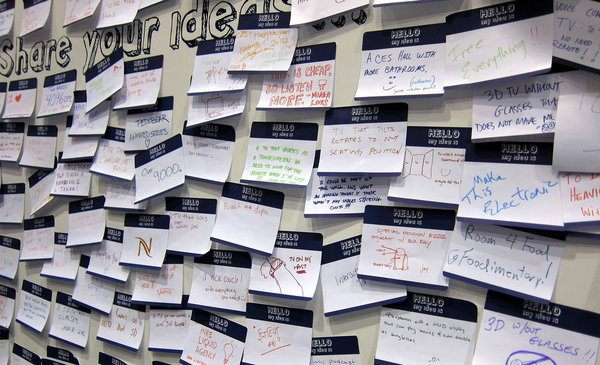The mostly highly admired brands are usually unique, original, fresh, and leading edge. In fact, many have invented or reinvented entire categories. To be that kind of a brand, an organization must be highly innovative. Element K CEO Bruce Barnes likes to talk about the “Virtuous Circle of Investment/Innovation.” It is very simple:
•Investing in customer-relevant product/service innovation leads to increased revenues
•Increased revenues enable continued product/service innovation
Innovative brands with innovative products, services, and marketing approaches typically make extensive use of creative problem solving and ideation (idea generation) techniques.
Creative problem solving usually requires two distinct phases: divergent thinking (ideation) and convergent thinking (idea analysis and evaluation). The purpose of ideation is to generate as many ideas as possible in as condensed a timeframe as possible.
Brainstorming is the most popular ideation technique. Brainstorming requires the following components to be successful:
•A well defined problem
•Two or more people together in a room. Ideally, you have a mix of people from different disciplines, including someone who knows nothing about the subject (to offer perspective) and a subject matter expert. Also, participants should be screened for divergent thinkers with diverse experiences who are willing to actively share their thoughts and ideas.
•Relaxation training, autogenics, psychodrama, sociodrama, and other techniques can help prepare people to ideate effectively. The intent is to break down mental blocks and preconceived notions and to get people to relax and to feel confident and safe from criticism. A warm-up exercise also helps to get people to think about things in new ways, to encourage “boundary-less” thinking.
•Providing participants with crayons and paper, Play-Dough, clay, Tinker Toys and other activities often helps people open up in their thinking.
•The exchange of ideas to generate more ideas
•Session ground rules: no criticism or judgments allowed
•The facilitator ensures that each person’s ideas are drawn out.
•No ideas are filtered out by the session facilitator – all are captured as presented, typically on a flip chart.
•The facilitator keeps the session moving so that people don’t have time to make premature judgments.
•The facilitator interjects questions to stimulate additional ideas when ideas are waning. Facilitators should have prepared a set of conceptual blockbusting questions before the session. “What if it were bigger? What if it were the opposite of what it is? What if we morphed it? What if it were only one-dimensional? What could we do to solve the problem if we had no money to do so? What could we do if we had unlimited financial resources? What if it were round? What if it were red? What is the high-tech solution? What is the low-tech solution? How would environmentalists solve the problem? How would farmers solve the problem? How would Albert Einstein solve the problem? How would a five-year-old girl solve the problem? How would the Chinese government solve the problem? How would your cat solve the problem? How does nature address this? What if you were the problem? What would you do? What if you were the solution? How would you feel? Etc.”
Other ideation techniques include the following:
•Visualization, guided imagery, fantasizing and envisioning the future
•Attribute listing, discovering connections between those attributes
•Mind mapping, diagramming relationships
•Question the problem and its assumptions, broaden the problem, look at the problem at a meta- level
•Applying ideas from one context to another (metaphorical thinking)
•Creating connections for two previously unconnected items (bisociation)
•Free associations (What is the first word that comes to your mind when I say…?)
•Forced relationships (Or, forcing an association between the problem or solution and random words)
•Conceiving of two unrelated entities occupying the same space (homospatial thinking)
•Stopping to further consider associations that initially make us laugh (laughter results from the unexpected connection between two things)
•Sketching and doodling
•Stream of consciousness writing
•Experience the problem emotionally, intellectually, spiritually and physically
•Incubation (walking away from the problem after intensely thinking about it)
•Live a life of diverse experience
Who drives the pace of change in your industry, you or one of your competitors?
The Blake Project Can Help You Create A Bolder Competitive Future In The Jobs To Be Done Workshop
Branding Strategy Insider is a service of The Blake Project: A strategic brand consultancy specializing in Brand Research, Brand Strategy, Brand Growth and Brand Education




